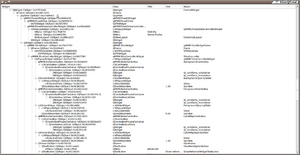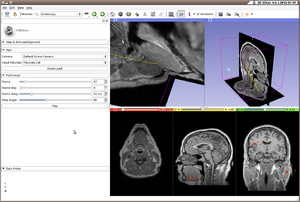Difference between revisions of "AHM2012-Slicer-Python"
| Line 258: | Line 258: | ||
== Refining the code and UI with slicerrc == | == Refining the code and UI with slicerrc == | ||
| + | |||
| + | Slicer supports a user-specific startup script called slicerrc | ||
| + | * Can be either in ~/.slicerrc.py or in location pointed to by SLICERRC environment variable | ||
| + | * Can do arbitrary startup actions: | ||
| + | ** load data | ||
| + | ** change the GUI | ||
| + | ** initiate computation | ||
| + | |||
| + | In practice, it is very convenient for developers to use the this feature to make shortcuts for interacting with their code. | ||
| + | |||
| + | See [https://github.com/pieper/SlicerRC] for examples that you can build from. | ||
| + | |||
| + | Here's an excerpt from that example: | ||
| + | <pre> | ||
| + | def endoscopy(): | ||
| + | print "SlicerRC - endoscopy setup..." | ||
| + | import imp, sys, os | ||
| + | endoPath = '%s/../../Slicer4/Modules/Scripted/Scripts' % slicer.app.slicerHome | ||
| + | if not sys.path.__contains__(endoPath): | ||
| + | sys.path.insert(0,endoPath) | ||
| + | |||
| + | mod = "Endoscopy" | ||
| + | sourceFile = endoPath + "/Endoscopy.py" | ||
| + | fp = open(sourceFile, "r") | ||
| + | globals()[mod] = imp.load_module(mod, fp, sourceFile, ('.py', 'r', imp.PY_SOURCE)) | ||
| + | fp.close() | ||
| + | |||
| + | globals()['e'] = e = globals()[mod].EndoscopyWidget() | ||
| + | |||
| + | |||
| + | def setupMacros(): | ||
| + | """Set up hot keys for various development scenarios""" | ||
| + | |||
| + | import qt | ||
| + | global endoscopy | ||
| + | |||
| + | macros = ( | ||
| + | ("Shift+Ctrl+2", endoscopy), | ||
| + | ) | ||
| + | |||
| + | for keys,f in macros: | ||
| + | k = qt.QKeySequence(keys) | ||
| + | s = qt.QShortcut(k,mainWindow()) | ||
| + | s.connect('activated()', f) | ||
| + | s.connect('activatedAmbiguously()', f) | ||
| + | print "SlicerRC - '%s' -> '%s'" % (keys, f.__name__) | ||
| + | |||
| + | # Install macros | ||
| + | if mainWindow(verbose=False): setupMacros() | ||
| + | |||
| + | </pre> | ||
== Limitations of python == | == Limitations of python == | ||
Revision as of 23:09, 7 January 2012
Home < AHM2012-Slicer-PythonContents
What is accessible via python
Qt
Interfaces are build with PythonQt which exposes most of the Qt interface so that sophisticated interfaces can be easily created.
import slicer
def widgetTree(root=""):
if not root:
root = slicer.util.mainWindow()
global treeItems
tree = qt.QTreeWidget()
tree.setHeaderLabels(["Widget", "Class", "Title", "Text", "Name"])
treeItems = {}
treeItems[root] = qt.QTreeWidgetItem(tree)
parents = [root]
while parents != []:
widget = parents.pop()
if not widget:
break
widgetItem = qt.QTreeWidgetItem(treeItems[widget])
children = widget.children()
for child in children:
treeItems[child] = widgetItem
parents += children
widgetItem.setText(0, str(widget))
try:
widgetItem.setText(1, widget.className())
except AttributeError:
pass
try:
widgetItem.setText(2, widget.title)
except AttributeError:
pass
try:
widgetItem.setText(3, widget.text)
except AttributeError:
pass
try:
widgetItem.setText(4, widget.name)
except AttributeError:
pass
tree.setGeometry(100, 100, 1000, 500)
tree.setColumnWidth(0,200)
tree.setColumnWidth(0,300)
tree.expandAll()
tree.show()
return tree
VTK and MRML
It is possible to implement the logic of the effect using VTK Python binding. You can get ideas of what is possible from the VTK tutorials.
Because MRML and most of the slicer functionality is written as VTK subclasses, they are available in python via the same mechanism.
class EndoscopyPathModel:
"""Create a vtkPolyData for a polyline:
- Add one point per path point.
- Add a single polyline
"""
def __init__(self, path, fiducialListNode):
fids = fiducialListNode
scene = slicer.mrmlScene
points = vtk.vtkPoints()
polyData = vtk.vtkPolyData()
polyData.SetPoints(points)
lines = vtk.vtkCellArray()
polyData.SetLines(lines)
linesIDArray = lines.GetData()
linesIDArray.Reset()
linesIDArray.InsertNextTuple1(0)
polygons = vtk.vtkCellArray()
polyData.SetPolys( polygons )
idArray = polygons.GetData()
idArray.Reset()
idArray.InsertNextTuple1(0)
for point in path:
pointIndex = points.InsertNextPoint(*point)
linesIDArray.InsertNextTuple1(pointIndex)
linesIDArray.SetTuple1( 0, linesIDArray.GetNumberOfTuples() - 1 )
lines.SetNumberOfCells(1)
# Create model node
model = slicer.vtkMRMLModelNode()
model.SetScene(scene)
model.SetName("Path-%s" % fids.GetName())
model.SetAndObservePolyData(polyData)
# Create display node
modelDisplay = slicer.vtkMRMLModelDisplayNode()
modelDisplay.SetColor(1,1,0) # yellow
modelDisplay.SetScene(scene)
scene.AddNodeNoNotify(modelDisplay)
model.SetAndObserveDisplayNodeID(modelDisplay.GetID())
# Add to scene
modelDisplay.SetPolyData(model.GetPolyData())
scene.AddNode(model)
# Camera cursor
sphere = vtk.vtkSphereSource()
sphere.Update()
# Create model node
cursor = slicer.vtkMRMLModelNode()
cursor.SetScene(scene)
cursor.SetName("Cursor-%s" % fids.GetName())
cursor.SetAndObservePolyData(sphere.GetOutput())
# Create display node
cursorModelDisplay = slicer.vtkMRMLModelDisplayNode()
cursorModelDisplay.SetColor(1,0,0) # red
cursorModelDisplay.SetScene(scene)
scene.AddNodeNoNotify(cursorModelDisplay)
cursor.SetAndObserveDisplayNodeID(cursorModelDisplay.GetID())
# Add to scene
cursorModelDisplay.SetPolyData(sphere.GetOutput())
scene.AddNode(cursor)
# Create transform node
transform = slicer.vtkMRMLLinearTransformNode()
transform.SetName('Transform-%s' % fids.GetName())
scene.AddNode(transform)
cursor.SetAndObserveTransformNodeID(transform.GetID())
self.transform = transform
Numpy
Slicer also comes bundled with numpy so many interesting array operations are easy to perform on image data.
Here's an excerpt from a working example:
#
# Get the numpy array for the bg and label
#
import vtk.util.numpy_support
backgroundImage = backgroundNode.GetImageData()
labelImage = labelNode.GetImageData()
shape = list(backgroundImage.GetDimensions())
shape.reverse()
backgroundArray = vtk.util.numpy_support.vtk_to_numpy(backgroundImage.GetPointData().GetScalars()).reshape(shape)
labelArray = vtk.util.numpy_support.vtk_to_numpy(labelImage.GetPointData().GetScalars()).reshape(shape)
CLI Modules
It is also possible to invoke slicer command line modules from python. These can be written in any language, but often rely on ITK for processing. In the near future SimpleITK should be available directly inside slicer. See the Slicer4 Python page for examples.
Here's an example from the Editor Module that calls the ModelMaker CLI:
def onApply(self):
#
# create a model using the command line module
# based on the current editor parameters
#
volumeNode = self.editUtil.getLabelVolume()
if not volumeNode:
return
#
# set up the model maker node
#
parameters = {}
parameters['Name'] = self.modelName.text
parameters["InputVolume"] = volumeNode.GetID()
parameters['FilterType'] = "Sinc"
# build only the currently selected model.
parameters['Labels'] = self.getPaintLabel()
parameters["StartLabel"] = -1
parameters["EndLabel"] = -1
parameters['GenerateAll'] = False
parameters["JointSmoothing"] = False
parameters["SplitNormals"] = True
parameters["PointNormals"] = True
parameters["SkipUnNamed"] = True
if self.smooth.checked:
parameters["Decimate"] = 0.25
parameters["Smooth"] = 10
else:
parameters["Decimate"] = 0
parameters["Smooth"] = 0
#
# output
# - make a new hierarchy node if needed
#
numNodes = slicer.mrmlScene.GetNumberOfNodesByClass( "vtkMRMLModelHierarchyNode" )
outHierarchy = None
for n in xrange(numNodes):
node = slicer.mrmlScene.GetNthNodeByClass( n, "vtkMRMLModelHierarchyNode" )
if node.GetName() == "Editor Models":
outHierarchy = node
break
if not outHierarchy:
outHierarchy = slicer.vtkMRMLModelHierarchyNode()
outHierarchy.SetScene( slicer.mrmlScene )
outHierarchy.SetName( "Editor Models" )
slicer.mrmlScene.AddNode( outHierarchy )
parameters["ModelSceneFile"] = outHierarchy
modelMaker = slicer.modules.modelmaker
#
# run the task (in the background)
# - use the GUI to provide progress feedback
# - use the GUI's Logic to invoke the task
# - model will show up when the processing is finished
#
self.CLINode = slicer.cli.run(modelMaker, self.CLINode, parameters)
self.statusText( "Model Making Started..." )
Using the console
(See J2's excellent demo video)
The python console in Slicer4:
- is a Qt widget that is part of CTK's extensions to PythonQt
- has syntax highlighting
- has command completion
- provides handy access for testing and experimenting
Writing a Scripted Module
The Endoscopy module is a good example to look at for writing a scripted module.
You can get started by using the ModuleWizard to create your skeleton module.
Then you implement the functionality using the methods described above:
- Use PythonQt to create the interface
- Implement the Logic with vtk/vtkITK/CLI Modules
- Access MRML Data via numpy
Refining the code and UI with slicerrc
Slicer supports a user-specific startup script called slicerrc
- Can be either in ~/.slicerrc.py or in location pointed to by SLICERRC environment variable
- Can do arbitrary startup actions:
- load data
- change the GUI
- initiate computation
In practice, it is very convenient for developers to use the this feature to make shortcuts for interacting with their code.
See [1] for examples that you can build from.
Here's an excerpt from that example:
def endoscopy():
print "SlicerRC - endoscopy setup..."
import imp, sys, os
endoPath = '%s/../../Slicer4/Modules/Scripted/Scripts' % slicer.app.slicerHome
if not sys.path.__contains__(endoPath):
sys.path.insert(0,endoPath)
mod = "Endoscopy"
sourceFile = endoPath + "/Endoscopy.py"
fp = open(sourceFile, "r")
globals()[mod] = imp.load_module(mod, fp, sourceFile, ('.py', 'r', imp.PY_SOURCE))
fp.close()
globals()['e'] = e = globals()[mod].EndoscopyWidget()
def setupMacros():
"""Set up hot keys for various development scenarios"""
import qt
global endoscopy
macros = (
("Shift+Ctrl+2", endoscopy),
)
for keys,f in macros:
k = qt.QKeySequence(keys)
s = qt.QShortcut(k,mainWindow())
s.connect('activated()', f)
s.connect('activatedAmbiguously()', f)
print "SlicerRC - '%s' -> '%s'" % (keys, f.__name__)
# Install macros
if mainWindow(verbose=False): setupMacros()

